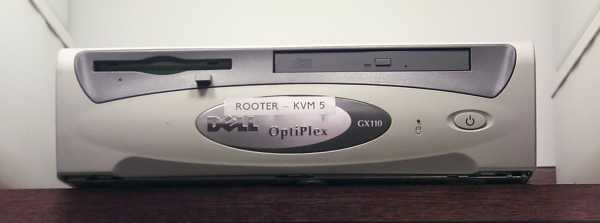 Home .
Home . Home .
Home .Rooter router was conceived as a small, low cost, high performance, energy efficient firewall router for SOHO network as part of the Router Evaluation project . A performance goal was set at 100 Mbit/second and a price goal was set at under 100 dollars. A power goal was set at under 25 watts. An additional goal was for silent or near silent operation. Read on if you want to hear how to build a low cost, low power, high performance router for your home office network.
The goal of full 100 Mbit/sec throughput gives a processing requirement of 500-600 MHz processor. A survey of ebay suggests small form factor PC's of this speed class can be had for 40-60 dollars plus shipping. A weekend crawl through a number of surplus computer stores turned up a Dell Optiplex GX110 with a 667 Mhz P3 for $69.95 plus tax. A quick test with a kill-a-watt meter showed the unit drawing 35 watts during POST with a hard drive. Holding my head right next to the unit was unable to discern any sound coming out of the system. At 12x14 inches the small form factor case is larger than most appliance routers but smaller than a standard PC. The GX110 had one onboard LAN port and offers two PCI slots on a riser card. All seemed reasonable so the machine was purchased and the project began.
The first step was to open the computer and remove the hard drive. The system was clean enough so no additional cleaning was required. The sound card was removed from the riser and two Dlink DGE-530T gigabit network cards were installed. The initial intent was to operate with a pair of Intel dual port 10/100 adapter but none were available and the Dlink cards were sitting in a pile for some future project.
A m0n0wall cd was placed in the cd-drive and a floppy in the floppy bay and the system was booted. The first boot was with a keyboard and monitor attached. First step was to go into the bios to disable the hard drive and change the boot sequence to boot from the cd first. The keyboard error check was also disabled. Monowall then booted and a lan address was assigned. Rooter router was then configured from a laptop using a web browser. The WAN port was connected to the network and throughput tests were performed. Rooter router managed a respectable 94 Mbit/second throughput, just a hair under the 95 Mbit/second measured with the laptop directly connected to the unit under test. The kill-a-watt meter showed rooter router drawing 24 watts when idle, 26 watts when the performance test was running.

Read about phase 2 of the project in the next chapter.
Copyright © 2001-2016 by Fractal
Hosting by ziandra.net